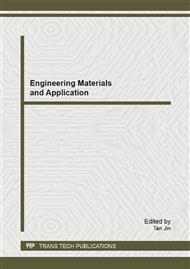[1]
S. Alker, V. Joy, P. Roberts, N. Smith, The definition of brownfield, J. Environ. Planning Manage. 43 (2000) 49-69.
Google Scholar
[2]
Q.Y. Cai, C.H. Mo, Q.T. Wu, A. Katsoyiannis, Q.Y. Zeng, The status of soil contamination by semivolatile organic chemicals (SVOCs) in China: A review, Sci. of the Total Environ. 389(2008), 209-224.
DOI: 10.1016/j.scitotenv.2007.08.026
Google Scholar
[3]
J. Xie, F.S. Li, Overview of the current situation on brownfield remediation and redevelopment in China, The World Bank Report 2010, pp.2-4.
Google Scholar
[4]
Y.F. Wei, Z. Zhong, Z.Y. Gu, Z, Qiu, C.B. Zhang, F.C. Sun, Chemical oxidation treatment for semi volatile organic compounds contaminated brownfield site: a case study, Advanced Materials Research 414(2012), 317-322.
DOI: 10.4028/www.scientific.net/amr.414.317
Google Scholar
[5]
D.A. House, Kinetics and mechanism of oxidations by peroxydisulfate, Chem. Rev. 62(1962) 185-203.
DOI: 10.1021/cr60217a001
Google Scholar
[6]
C. Liang, C.J. Bruell, M.C. Marley, K.L. Sperry, Thermally activated persulfate oxidation of trichloroethylene (TCE) and 1, 1, 1-trichloroethane (TCA) in aqueous systems and soil slurries, Soil Sediment Contam. 12(2003), 207-228.
DOI: 10.1080/713610970
Google Scholar
[7]
M.A. Dahnami, K.C. Huang, G.E. Hoag, Sodium persulfate oxidation for the remediation of chlorinated solvents, Water, Air, & Soil Pollution: Focus. 6(2006) 127-141.
DOI: 10.1007/s11267-005-9002-5
Google Scholar
[8]
K.L. Sperry, M.C. Marley, C.J. Bruell, C. Liang, J. Hochreiter, Iron-catalyzed persulfate oxidation of chlorinated solvents, In: Gavaskar, A.R., Chen, A.S.C. (Eds. ), Remediation and Recalcitrant Compounds, Battelle Press, Columbus, Ohio, 2002, p.1158.
Google Scholar
[9]
R.H. Waldemer, P.G. Tratnyek, R.L. Johnson, J.T. Nurmi, Oxidation of chlorinated ethenes by heat-activated persulfate: kinetics and products, Environ. Sci. Technol. 41(2007) 1010-1015.
DOI: 10.1021/es062237m
Google Scholar
[10]
C. Cuypers, T. Grotenhuis, J. Joziasse, W. Rulkens, Rapid persulfate oxidation predicts PAH bioavailability in soils and sediments, Environ. Sci. Technol. 10(2000) 2057-(2063).
DOI: 10.1021/es991132z
Google Scholar
[11]
T.T. Tsai, C. M. Kao, T.Y. Yeh, M. S. Lee, Chemical oxidation of chlorinated solvents in contaminated groundwater: review, Pract. Period. Hazard. Toxic Radioact. Waste Manage. 12(2008) 116-126.
DOI: 10.1061/(asce)1090-025x(2008)12:2(116)
Google Scholar
[12]
A. Tsitonaki, B. Petri, M. Crimi, H. Mosbak, R.L. Siegrist, P.L. Bjerg, In situ chemical oxidation of contaminated soil and groundwater using persulfate: a review, Crit. Rev. Environ. Sci. Technol. 40(2010) 55-91.
DOI: 10.1080/10643380802039303
Google Scholar
[13]
C.J. Liang, I.L. Lee, I.Y. Hsu, C.P. Liang, Y.L. Lin, Persulfate oxidation of trichloroethylene with and without iron activation in porous media, Chemosphere 70(2008) 426-435.
DOI: 10.1016/j.chemosphere.2007.06.077
Google Scholar
[14]
F. Nadim, K.C. Huang, M.A. Dahmani, Remediation of soil and ground Water contaminated with PAH using heat and Fe(II)-EDTA catalyzed persulfate oxidation, Water, Air, & Soil Pollution: Focus. 6(2006) 227-232.
DOI: 10.1007/s11267-005-9008-z
Google Scholar
[15]
P.F. Killiana, C.J. Bruellb, C.J. Liang, M.C. Marley, Iron (II) activated persulfate oxidation of MGP contaminated soil, Soil & Sediment Contamin. 16(2007) 523-537.
DOI: 10.1080/15320380701623206
Google Scholar
[16]
G.S. Brown, L.L. GS, B.M. Thomson, Permanganate oxidation of sorbed polycyclic aromatic hydrocarbons, Waste Manag. 23(2003) 737-740.
DOI: 10.1016/s0956-053x(02)00119-8
Google Scholar
[17]
M.H. Schroth, M. Oostromb, T.W. Wietsmac, J.D. Istokd, In-situ oxidation of trichloroethene by permanganate: effects on porous medium hydraulic properties, J. Contam. Hydrol. 50(2001) 79-98.
DOI: 10.1016/s0169-7722(01)00098-5
Google Scholar
[18]
E.L. Bier, J. Singh, Z.M. Li, S.D. Comfort, P.J. Shea, Remediating hexahydro-1, 3, 5-trinitro-1, 2, 5-trazine-contaminated water and soil by fenton oxidation, Environ. Toxicology and Chem. 18(1999) 1078-1084.
DOI: 10.1002/etc.5620180602
Google Scholar
[19]
F. Luck, Wet air oxidation: past, present and future, Catalysis Today, 53(1999) 81-91.
DOI: 10.1016/s0920-5861(99)00112-1
Google Scholar
[20]
C.J. Liang, C.F. Huang, Y.J. Chen, Potential for activated persulfate degradation of BTEX contamination, Water Research, 42(2008), 4091-4100.
DOI: 10.1016/j.watres.2008.06.022
Google Scholar


